Jon Mac's Blog, page 4
October 2, 2011
Mythik Imagination #1 Print Preview
The print version of Mythik Imagination #1 is just about ready. To see what it will look like, here is an on-line print preview:
Open publication - Free publishing - More magazine
You can also view it by going to Mythik Imagination #1 Print Version.
Thanks for reading!
Open publication - Free publishing - More magazine
You can also view it by going to Mythik Imagination #1 Print Version.
Thanks for reading!
Published on October 02, 2011 13:14
September 30, 2011
Weekend eBooks
 This week I plan to do a little Kindling and have loaded up some cool new eBooks (ha ha, yep I read on the iPhone! Crazy...) You also might want to check these out:
This week I plan to do a little Kindling and have loaded up some cool new eBooks (ha ha, yep I read on the iPhone! Crazy...) You also might want to check these out:First up is Semper Audacia by M. Pax. $0.99
"Space opera. Novelette. 13,200 words. Alone. Leda is the last living member of the brigade, the sole defender of her world. War took everyone she knew, leaving her in the company of memories and ghosts. Or is it madness?
The siren blares. The enemy is coming. Or is it? The approaching vessel isn't a friendly design, but it answers with the correct code. Leda must figure out whether the arrival is reinforcements or the final assault. In an aging flyer, she ventures out to meet her world's fate, the last stand."
 Next is
Hunted - The Flash Gold Chronicles
by Lindsay Buroker. $1.49
Next is
Hunted - The Flash Gold Chronicles
by Lindsay Buroker. $1.49"Self-taught tinkerer Kali McAlister is determined to build an airship and escape the frigid Yukon forever. Unfortunately, she's the heir to the secrets of flash gold, an alchemical energy source that tends to make her a popular target for bandits, gangsters, and pirates.
With the help of her bounty-hunting business partner, Cedar, Kali has outwitted and eluded attackers before, and she thinks she's prepared for anything. Then her ex-fiancé strolls into her workshop.
As if fooling her once wasn't enough, he aims to embroil her in a fresh scheme. Meanwhile, a new nemesis is stalking her, a shrouded figure with an arsenal of deadly machines that make Kali's inventions seem like toys. This time, it'll take more than her ingenuity and Cedar's combat skills to survive.
Hunted is a 27,000-word steampunk novella.
Printed page count equivalent: 120"
 And
Imperium - A Caulborn Novel
by Nicholas Olivo. $2.99
And
Imperium - A Caulborn Novel
by Nicholas Olivo. $2.99"Vincent Corinthos leads a triple life. As a secret agent, he handles paranormal threats; as a god, he protects his followers from evil forces; as a stock clerk, he keeps the back room of an antique store tidy.
When one of his fellow agents goes missing, Vincent begins with the usual suspects. His investigation reveals that Boston's latest supernatural threat is also waging war on his followers, and has diabolic intentions for the city's paranormal citizens.
Now, with the aid of a new partner and a gremlin, Vincent must locate the missing agent, defend his followers and learn the identity of his adversaries before they can revive a malevolent force that's been dormant since World War II."
I'm already a fan of Buroker's Flash Gold series, and the premises of Semper Audacia and Imperium look pretty awesome. Now I just need to find the time to actually read...
Published on September 30, 2011 16:49
September 29, 2011
Mythik Imagination #1 is a Free eBook
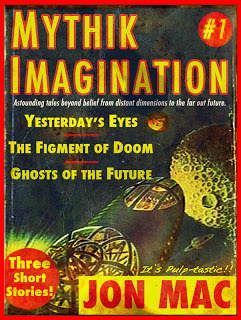 Mythik Imagination #1
is now a free eBook on Smashwords. It's also free on Barnes & Noble and iTunes. It's not free for the Amazon Kindle yet, but if any volunteers out there would like to let Amazon know they should adjust the price to free, that would be way cool. Thanks to Savvy Self Publishing for the tip on how to make Kindle eBooks free!
Mythik Imagination #1
is now a free eBook on Smashwords. It's also free on Barnes & Noble and iTunes. It's not free for the Amazon Kindle yet, but if any volunteers out there would like to let Amazon know they should adjust the price to free, that would be way cool. Thanks to Savvy Self Publishing for the tip on how to make Kindle eBooks free!I'm not quite ready to announce a release date for Mythik Imagination #2 Weird West Edition just yet, but hopefully it will be ready soon.
I'm trying to make up for time lost over the summer, and if all goes according to plan, the next issues of Mythik Imagination will be much closer together :)
Published on September 29, 2011 07:02
September 28, 2011
Weird Wednesday - Strange Places
So I've been collecting a small database of, shall we say, odd places. I have a theory that if you dig around enough, you can probably find something weird about just about any place. But the locations in this list sort of stand up and shout out how odd they really are and don't require much digging at all. I've been using the list for possible locations in some Weird West stories. Strangely enough most of them have the word "canyon" or "devil" in their name. Bonus points if they have both. And if it's not "canyon" or "devil," it's a mountain. So if you ever see a sign pointing the way to "Devil Mountain Canyon," go the other way. Alright, now for the list:
Published on September 28, 2011 07:30
September 26, 2011
Spaceship Links
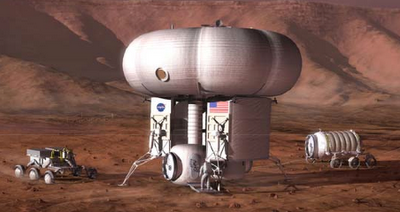
Well, my amateur rocket science obsession has just about run its course. Until the resulting stories are published, anyway ;) But for those of you who haven't been completely driven away by all the equations, here are some final cool links about the final frontier:
Basics of Space Flight - A complete tutorial from JPL. It starts at the beginning and walks you through every aspect of space travel.The N Prize - That's right, launch your very own tiny satellite into space, and win a prize! (Please let me know if you actually succeed in doing this, cuz it seems waaaay cool.)SpinCalc - A handy little program that lets you see how much artificial gravity you generate by spinning.Orbit Diagrams - Courtesy of the Jet Propulsion Laboratory, this cool site shows all kinds of interesting views of our little home solar system.Mars Design Reference - From NASA, this has everything you ever wanted to know about a real-life trip to Mars.Thruster Calculator - You can input your own numbers or let the computer do it for you (Try out the AM-Beam Torchship (which is powered by anti-matter,) put in a Mass Ratio of 4 and reach 23% of the speed of light!Okay, that's that for that. Next up: The Weird West!
Published on September 26, 2011 07:00
September 22, 2011
How To Build A Spaceship - Part 4
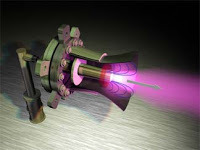 MPD ThrusterIn Part 3, we plugged our numbers into the equations and did the calculations. So let's look at what we came up with:
MPD ThrusterIn Part 3, we plugged our numbers into the equations and did the calculations. So let's look at what we came up with:Mythik Magnetoplamsadynamic Mars Expedition Ship
Mission - Fly to Mars, look around, and return to Earth.
Distance - .5 AU or 74,799,000,000 meters.
Ship - Orbit to orbit Mars Expedition vessel. "Fire Baton" class generating 1G artificial gravity by spinning around the central core. The artificial gravity is good for the health of our crew and also helps simplify things like plumbing and all the other things that act surprisingly weird in micro gravity. It's powered by two 15MW nuclear reactors, generating 6MW of electrical power.
Length - 125 Meters. The reactors are at one end, the Habitat Module at the other end, connected by trusses from the central core. The distance of our crew from the reactors, combined with the radiation shield, keeps the amount of radiation exposure to safe levels for the duration of the mission. There is a "storm cellar" in the center of the Habitat with extra shielding in case of solar flares, etc.
Thrusters - Six Magnetoplasmadymaic (MPD) Thrusters, which have 25 Newtons of thrust each. Three thrusters are on each side of the central core. Our design is what's known as Nuclear Electric Propulsion. The nukes make the electricity which powers the thrusters. Another design is Nuclear Thermal Propulsion, where the nukes are the thrusters.
Wet Mass - 145,400kg
Dry Mass - 75,400kg
Propellant Mass - 70,000kg
Propellant Tanks Mass - 4,000kg
Drive - 32,200kg - Includes all power systems, radiation shield, radiators, etc.
Hull - 5,000kg - Includes central core, thrusters, truss, etc.
Payload - 34,200kg - Consists of TransHab inflatable crew module, including all life support systems, navigation, control systems, etc.
Thrust - 150 Newtons
Specific Impulse - 5,000 seconds
Mass Ratio - 1.92
Exhaust Velocity - 49,050m/s
Ship Delta V - 32,210m/s
Acceleration - .001 m/s
Travel Time - 197 Days (6.6 Months)
Mission Delta V - 17,568m/s
Okay! There are a couple of issues:
1. We're using all of our electrical power for thrust, with nothing left to power all the other systems on the ship. We could solve this by using lesser thrust or taking away two thrusters. But then our travel time would be extended. Or, we could find a way to make our reactors more efficient. 2. We don't have quite enough Ship Delta V to make a round trip. We could solve that by adding more propellant or squeezing out more Specific Impulse from our thrusters. 3. If we solve #1 & #2, we still can't do much once we get to Mars. We have no way of landing on Mars. We also didn't take into account the amount of Delta-V it would take to make the course corrections to match orbits with Mars (and Earth on the return trip.) We could solve that by sending another ship ahead of time that contains the payload of Mars Lander, Mars Habitat, extra propellant, etc.
Also note, that this ship is an orbit-to-orbit vehicle. It needs other rockets to launch its parts into space, then it needs to be constructed in space. It cannot land or take off from a planet. If you want an all-in-one ship, it gets a lot more complicated.
But this does give you a basic idea of what it takes to get to another planet. You can see that Thrust and Specific Impulse are very important if you have a far destination and want a reasonably quick travel time. The fun part is trying out different numbers from various near-future possibly realistic drives and seeing what you come up with. What if there some kind of technological breakthrough and a power source was developed that generated 30MW of electrical power and only weighed 10,000kg? Well then we could string together 25 of our 25N thrusters and get 625N of thrust! Then we could save the weight from the reactors, add some more propellant and cut our travel time less than 4 months! Of course, that's kind of like building a race car out of dozens of lawn mower engines, but you get the idea.
What I learned from all this is that we really need lighter more efficient ways to produce electrical power, or lighter and more efficient (and safer) nuclear engines. Maybe something along the lines of a Nuclear Thorium Laser.
I plan to use a design similar to the Mythik Magnetoplasmadynamic Mars Expedition Ship in an upcoming story. It's about a trip to Mars that doesn't quite go as planned. Think Poltergeist in Space. That's right, a hard SF horror story.
Hopefully, I haven't completely turned off my few readers with all the equations. You had at least a little bit of fun, right?
For your spaceship designing enjoyment, I have put together a little Excel spreadsheet that does all the evil math for you. Feel free to download the Mythik Spaceship Calculator. I based it on a cool spreadsheet from Rocketpunk-Manifesto called the Rocketpunk Manifesto Travel Planner.
Many thanks, also, to Atomic Rockets, a website filled with infinite spaceship goodness. If you go to the Atomic Rockets Engine section, you can see the equations we used (and awesome pictures and examples) in more detail. And check out the Atomic Rockets Drive Table to see what kind of drives you can plop onto your spaceship to see how it affects travel time etc.
Other parts of this series:How To Build A SpaceshipPart 1Part 2Part 3
Part 4
Published on September 22, 2011 06:30
September 21, 2011
How To Build A Spaceship - Part 3
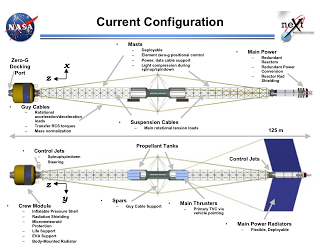
In Part 2 we looked at some of the variables we need to know or calculate to determine our spaceship design. Now, we'll look at the elements of the ship itself.
Just as a Ferrari has specific parts such as engine, chassis, suspension, brakes, body etc., a spaceship can be broken down into necessary, specific components.
We'll need a drive (no warp drives here!) and propellant, hull, and a payload section.
The design I'm going to initially copy is from the NASA Artificial Gravity for Human Exploration Missions report. I must admit, I picked this one because it looks cool and has some rather interesting quirks that I think would make for a great story setting. It uses the "fire baton" concept to create artificial gravity by spinning the entire ship. The power reactors are on one end, and the payload (the habitat or crew module) is balanced on the other end. The ship rotates around the center, where the propellant tanks and thrusters are located. Our thrust will be provided by six Magnetoplasmadynamic (MPD) thrusters, which get their power from six turbo alternators which convert the thermal energy from two nuclear reactors into electrical power. So it will break down like this:
Drive - 2 nuclear reactors, 6 turbo alternators, radiators, radiation shield and assorted gizmos.Propellant - This is the Lithium propellant that our MPD thrusters will use.Hull - this is the central core, the truss that connects the Drive and Habitat modules to the core, and guy wires, etc. In this particular design, our thrusters are also considered to be part of the Hull section, although they are commonly in the Drive section. This will also include the mass of our tanks that hold the propellant. You'll note the hull is nothing like an ocean liner or the Starship Enterprise. It is pretty much just a skeleton that connects the other parts of the ship. Ah, the elegance of space travel!Payload - This consists of our habitat module, which is a self-contained, inflatable TransHab design.First, we'll need to figure out how much mass our spaceship has...As anybody who's ever read The Cold Equations knows, mass is serious business for a spaceship. Pretty much everything else depends on what the mass is. The most important numbers are the Total Mass (also called Wet Mass) and the Empty Mass (also called Dry Mass or the mass of everything except the propellant.) For our design, we also need to be sure the masses of our Drive and Payload are roughly equal, since they will be rotating around the central core. Thanks to the lightning slide rules of NASA we already have some good numbers to start out with. That's important, because for "realistic" spaceship design, we really need accurate estimates for the mass of various systems such as life support and reactors and whatnot. It breaks down like this:Drive - 32,200kg - This includes our reactors, turbo alternators, radiation shield, radiators, etc.Propellant - 70,000kg - We might modify this number later to optimize it for the mission.Hull - 9,000kg - just a bunch of exotic metal and composites, but necessary!Payload - 34,200kg - Our payload is us, the astronauts! And everything necessary to keep us alive and cozy for a lengthy voyage to the red planet.Add it all up and we come up with 145,400kg or about 145 metric tons.
Now, what about these sci-fi sounding Magnetoplasmadynamic MPD thrusters and nuclear reactors and turbo-alternators? As you will see, some of the most important factors in going anywhere in space are power and thrust and specific impulse. You can read all about the MPD thrusters, but for now we'll just use the data in the Nasa Artificial Gravity Report. We'll estimate that each thruster will use 1 Megawatt (MW) of power and that it will generate 25 N of thrust and have a Specific Impulse (Isp) of 5000 seconds. We'll use 6 thrusters for a total of 150N of thrust. The nuclear reactors generate heat energy and that is converted to electricity by the turbo alternators. The reactors actually generate 15MW of heat energy each, for a total of 30MW, of which we are only able to squeeze out 6MW of usable electricity, so if our electricity conversion was more efficient, we'd be able to use more power. But, we're stuck with just 6MW for now.
Also, we're using up all of our electricity output for the thrusters. We really should set aside some power for little things such as life support systems and computers and communications, etc. But let's not worry about that for now; let's crunch some numbers!
Step-1: Find the distance (D) we need to travel. We're going to Mars, so the distance is .5 Astronomical Units, or about 74.8 million kilometers. To make things simpler, we'll multiply that by 1000 to get the result in meters.
D = 74,800,000,000m
Step-2: Figure our Total Mass (M), which is 145,000kg.
M = 145,000kg
Step-3: Find our Mass Ratio (R.) Our Total Mass (Wet Mass) is 145,400kg. Our Propellant is 70,000kg, so our Dry Mass (Mass without Propellant) is 145,400 - 70,000 = 75,400. Mass Ratio = Total Mass / Dry Mass, so 145,400 / 75,400 = 1.92.
R = 1.92
Step-4: Find our Exhaust Velocity (Ve) which is Isp * 9.81. So it is 5000 * 9.81 = 49,050 meters per second.
Ve = 49,050m/s
Step-5: Let's see what our Ship Delta-V is. We use the Rocket Equation, which is Δ = Ve * ln[R] Hah, yeah right. Okay, the triangle is the symbol for Delta-V. ln is the Natural Logarithim of R, which is our Mass Ratio. Just switch your Mac or PC built-in calculators to scientific mode and type 1.92 then press the ln key then multiply that by our Ve, which is 49,050. So, Δ = 49,050 * ln[1.92] = 31,996m/s.
Δ = 31,996m/s
Step-6: Now let's see what our acceleration is. Acceleration (A) = Thrust (N) / Mass (M). So we have A = 150N / 145,000kg = .001 m/s.
A = .001 m/s
Step-7: Okay, let's put some of those numbers to work! Using the Brachistochrone Equation, we can find out how long it will take to get to Mars with amount of thrust we found in Step-6. This means we will accelerate constantly till we get to the halfway point, then flip around and decelerate until we come to a stop at our destination. T (time in seconds) = 2 * Square Root [Distance / Acceleration] so it will be T = 2 * Sqrt[74,800,000,000 / .001] = 17,297,398 seconds. Well divide that by 86,400 to convert from seconds to days, which gives us: 200 days.
T = 200 days
Step-8: We need to determine our Mission Delta-V. That will be Mission Delta-V = 2 * Square Root[D*A] so Mission Delta-V = 2 * Sqrt[74,800,000,000 * .001] = 17,297m/s
Mission Δ = 17,297m/s
So once we put all of that together, we can get to Mars in about 200 days or 6.5 months. We have enough Delta-V to get there, but wait! Our Ship Delta-V is 31,996 and our Mission Delta-V is 17,297. But we need to multiply that by 2 for a round trip. So our Mission Delta-V is really 34,594. So we'll be about 2,500 m/s short on the way back home.
Here's a summery of all the eye-glaizing mathematical goodness of our ship:
D = 74,800,000,000m
D is distance in meters
M = 145,000kg
M is mass in kg
R = Mw / Md
R is Mass Ratio
Mw is Wet Mass in kg
Md is Dry Mass kg
R = 1.92
Thrust = 150N (Newtons)
Specific Impulse = 5000 sec.
Ve = Isp * 9.81
Ve is Exhaust Velocity in m/s
Isp is Specific Impulse in seconds
Ve = 49,050m/s
Δ = Ve * ln[R]
Ve is Exhaust Velocity is m/s
R is Mass Ratio
Δ = 31,996m/s
A = Thrust / Mass
A is Acceleration in m/s
A = .001 m/s
T = 2 * Sqrt[D / A]
T is Transit Time in seconds
D is Distance in meters
A is Acceleration in m/s
Divide by 86,400 to convert seconds to days
T = 200 days (6.7 months)
Mission Δ = 2 * Sqrt[D * A]
D is Distance in meters
A is Acceleration in m/s
Mission Δ = 17,297m/s
In Part 4 we'll look at what all those numbers mean and whether they really are realistic or not. And just for suffering through all the math, you will also get a prize!
Published on September 21, 2011 16:25
September 20, 2011
How To Build A Spaceship - Part 2
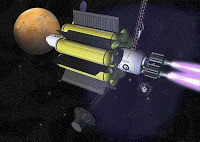 Okay, so the Ferrari Road Trip from Part 1 showed us that we needed to know a few things to figure out the time and cost of our trip. And Flying Cars, Jetpacks and Video Phones showed us that just because something hasn't been done, doesn't mean it can't be done. And, if in space, no one can hear you scream, then no one can charge your credit card, either, right? So we're going to almost forget about cost for now, except for two terms: "Realistic" and "Sci-Fi." I'll define those two terms:
Okay, so the Ferrari Road Trip from Part 1 showed us that we needed to know a few things to figure out the time and cost of our trip. And Flying Cars, Jetpacks and Video Phones showed us that just because something hasn't been done, doesn't mean it can't be done. And, if in space, no one can hear you scream, then no one can charge your credit card, either, right? So we're going to almost forget about cost for now, except for two terms: "Realistic" and "Sci-Fi." I'll define those two terms:"Realistic Cost" - If enough people in the right places want to do it, and it's based on something that somebody really smart really came up with, then it can be done eventually."Sci-Fi Cost" - If Old Ben can buy two 1-way tickets (Droids ride free) on the Millennium Falcon for 17,000 somethings, then that's all that matters.So forget about cost for now, except to say that we'll use "Realistic Cost" and that any power plant or engine that we consider would be something our Rocketpunk characters would willingly spend lots of time and money to develop.
So much for cost. What we're most interested in is realistic time frames for our trips in space. So that means we'll have to figure out our power and fuel and propellant requirements. We'll also need to know the distances involved. Pretty much just like our little jaunt in the 250 GT from LA to NYC, right? Surprisingly, yes. Hey, it ain't rocket science!Oh wait, it is rocket science. And there, dear reader, is the cool thing. There's a reason those Golden Age SF writers had Boy Scouts working out orbital mechanics on the back of an envelope. It's because they could! Once you know the right equations, it's pretty much plug and play. But wait, that's for a rough approximation. Those calculations might get you 9/10's of the way there, but that last 10% is going to look awfully important when you miss Mars by a few million kilometers and your shiny spaceship becomes a lifeless permanent fixture of the solar system. So that's where the real rocket science requiring really big brain cells comes in, to get all those extremely important little details exactly right. Lucky for us, we don't need to be that exact. Our rough approximation will work just fine for "realistic" space flight in our Mythik Universe.
Having said that, I do need to point out that on the Rough Rocket Science Approximation Scale, I am currently about half way through the Kindergarten level. So keep that in mind if my calculations send us to Mercury instead of Mars, or into the Sun, or anywhere but Mars. I know, we could fly right through a star or bounce too close to a supernova, and that would end our trip real quick, wouldn't it?
So here are the variables we need to know about to make our spaceship:Distance MassPropellantMass RatioSpecific ImpulseExhaust VelocityThrustShip Delta-VMission Delta-VTransit TimeDistance - As I'm sure you're aware, space is really big. It's so big, in fact, that astronomers (and spaceship designers like us) use units called AU (Astronimical Unit) which is equal to the average distance from the Earth to the Sun (about 149 million kilometers.) Naturally, our Earth is 1 AU from the Sun. Here's a handy table:
Planet Distance from Sun in AU
Mercury 0.39
Venus 0.72
Earth 1.0
Mars 1.5
Jupiter 5.2
Saturn 9.5
Uranus 19.2
Neptune 30.1
Pluto 39.5
So let's look at our destination, Mars. It is only .5 AU further from the Sun than Earth is. So that means we'll only have to travel about 74.5 million kilometers. Heh, yes, we are simplifying things a bit. But even so, you can see that any destination further than Mars will take a lot of effort to reach!
Mass - On Earth, we think of this as how much something weighs. But while weight will change based on the environment, mass is constant. So if you weigh 75kg on earth, your weight will be less on the Moon, but the mass will remain 75kg (kilograms.) Get used to kg and the metric system (Royal With Cheese - they call it that because of the metric system, right?) because we'll be using it a lot. We'll need to know how much total mass our ship has. That will enable us to determine our acceleration and our mass ratio.
Propellant - Rockets work by using Newton's Third Law. The rocket exhaust goes out the back at a high velocity. This makes the rocket go the other direction (forward.) That stuff that gets pushed out the exhaust is called propellant. In the Space Shuttle main engines for example, Liquid Hydrogen and Liquid Oxygen mix together and ignite and are both the fuel and the propellant. For some engines, like an Ion engine, propellant is not the same as fuel. Propellant (also called reaction mass) is just whatever you use to shoot out the back end of the rocket to make it accelerate the opposite direction. The units used are kg. Our Ferrari used its engine to turn the wheels which pushed against the road which caused the car to move forward. You could say the road (or the Earth) is the propellant. Our ship doesn't have a road, so it will need to carry its propellant.
Mass Ratio - The is the ratio of how much propellant you have compared to your ship's overall mass. If you have 10 tons of propellant and the total mass of the ship (propellant + everything else) is 15 tons, then the mass ratio is 3. The equation is Mass Ratio = Mass With Propellant / Mass Without Propellant. See, not too hard, right?
Specific Impulse - This often abbreviated as Isp. This is sort of the equivalent of a car's gas mileage. For our ship, it means how long until we run out of propellant. The units used are seconds. The Space Shuttle's main engines have about 453 seconds of Isp. That's not enough to get to Mars. Isp is dependent on engine type. Some engines have high Isp, some have low Isp. If you have a high Isp, you can use less propellant, which saves weight, or you can go further and do more things (like maneuver and decelerate) with the same amount of propellant.
Exhaust Velocity - The units used are meters per second, or m/s. We can determine the Exhaust Velocity by multiplying the specific Impulse by the gravitational constant or 1G, which is 9.81 m/s. So the equation is: Ve = Isp * 9.81. The Exhaust Velocity (Ve) of the Space Shuttle Engine is 453 * 9.81 = 4443 m/s. Since we just multiplied our Specific Impulse by a constant, you can see that Exhaust Velocity is just another way of expressing our Specific Impulse. To put it another way, a certain Isp will always have the same Ve. Right? Yep.
Thrust - This is how much acceleration our engine can generate. The units used are (N) Newtons. Naturally, different engines make different amounts of thrust. Using our Space Shuttle example, one of the three main engines makes 1,750 kN (kilo Newtons) of thrust. So that's 1,750,000 Newtons. Our ship will have, um, a lot less thrust. But our Isp will be much higher, so we'll be able to slowly accelerate for a much longer time than the Space Shuttle. It'll sort of be like a tortoise vs. hare scenario.
Delta-V - This is the really fun one. Delta-V is determined by the Rocket Equation, which is over 100 years old. Delta-V means change in velocity, and shows how much our ship can change its speed, which is important when accelerating to distant planets and then slowing down to orbit and sightsee. Delta-V = Exhaust Velocity * ln[Mass Ratio] The unit used is m/s. I'll explain the ln thingy later. This is really the true analog to a car's gas mileage. Any maneuver in space requires some amount of Delta-V. From a hard SF writer's standpoint, you could use Delta-V as a sort of Technology Currency. You gotta pay to play, and if you want to play in the outer planets or (even more so) nearby stars, you better be able to afford lots of Delta-V. If you don't have enough Delta-V required for a mission in your propellant tanks, then you can't do that mission. All the cool missions, of course, take lots of Delta-V. Which brings us to the next item...
Mission Delta-V - This is how much Delta-V it requires to get to a certain place in space. It depends on gravity and orbits and whatnot. You know, rocket science stuff. We'll deal with it later, but just know that our ship Delta-V needs to be equal to or greater than the Mission Delta-V (and double the Mission Delta-V for a round trip.)
Transit Time - The units are in days, months or years. Very roughly speaking (Kindergarten level rocket science, remember?) there are three ways to get some place in our Solar System. 1. Use something called a Hohmann Transfer Orbit. This is also known as as a minimum Delta-V, maximum transfer time orbit. It gets you where you want to go and doesn't require sci-fi unrealistic drives to get there. But it takes a long time. If your ship can come up with enough Delta-V (even the minimum amounts are hard,) then it will take 8.5 months to get to Mars. You turn on your rockets at the beginning, then coast. Then when you get close to the destination, you do another rocket "burn" and match orbit with the lovely red planet. Oh, and it also only works like this when the planets are lined up correctly. So if you miss your "launch window" for the Hohmann Earth to Mars orbit, you need to wait over a year and a half before the next window. That also means that once you get to Mars, you need to be able to stay alive long enough for the next window to open up. That's pretty annoying. 2. The other extreme is a Brachistochrone Orbit. The cool thing about this is that you can come and go whenever you feel like it. You fire up your engines and accelerate till you are half way to Mars. Then you flip around and fire the engines the opposite direction to decelerate the last half of the trip. The drawback to this is that it uses (pardon the pun) astronomical amounts of Delta-V. Yep, that's the problem with trying to be anywhere close to "realistic." Anything fun takes really large amounts of Delta-V. 3. The last way is Semi-Brachistochrone, which is somewhere in between the first two. It involves more "burning" that Hohmann, and more "coasting" than Brachistochrone.
And, just by sprinkling a few of these terms in a few strategic places, a story will at least have a more hard SF feel to it. "We don't have enough Delta-V to catch the space pirate, Captain!" It's better than complete technobabble, right?
Anyway, with just these 10 simple things you can conquer the universe! Or at least the inner Solar System. On paper. And that's exactly what we'll do in Part 3 when I show you how to build the Mythik Magnetoplasmadynamic Artificial Gravity Mark VII Mars Expedition Spaceship!
Published on September 20, 2011 06:00
September 17, 2011
How To Build A Spaceship - Part 1
 1961 Ferrari 250 GT CaliforniaSo you wanna build a spaceship, eh? Well, first we are gonna need a car. A Ferrari, in fact.
1961 Ferrari 250 GT CaliforniaSo you wanna build a spaceship, eh? Well, first we are gonna need a car. A Ferrari, in fact. That's what we'll use for this little opening metaphor, anyway. Don't worry, it will be a lot more fun than a typical "If Train A leaves Chicago at 50mph..." story problem. This metaphor will get us into space!
Let's say you want a fun road trip from from Los Angeles to New York City. Being a curious and thrifty person, you also want to know how long it will take and how gas you'll need. To determine these things, you need to figure out a bunch of other things. We'll simplify our trip (this is, after all, just a metaphor) and say that you will drive non-stop, Smokey And The Bandit style. We will need to know how far it is from LA to NYC, how fast your car can go, what kind of gas mileage the car gets at that speed and how much gas the car's fuel tank holds. We're going to say "who cares" to the cost of both gas and car and "borrow" a car, Ferris Bueller style.)
So here are the things we can find out after a quick bit of Googling:Distance from LA to NYC = about 2800 freeway milesAverage speed = 65mph (estimated most efficient speed for bright red Ferrari or Black & Gold Trans-Am. At higher speeds, the lost time due to traffic tickets and possible loss of license would hurt our overall travel time too much.)1961 Ferrari 250 GT California fuel mileage = 16 mpgSize of Ferrari fuel tank = 31.7 gallonsWe can plug that info to plug into a few simple equations, and find:
Time = 43 hoursFuel used = 175 gallonsRefueling stops = 5.5 stops to refuel
So let's put all those shiny numbers together. It will take us 43 hours to get to NYC. No, wait! We need to add the time it takes to stop at the gas station. We can't really make a half of a stop, so we'll round up to 6 fuel stops. Say about 10 minutes per stop, so that adds an extra hour. So our final numbers are:
LA to NYC Ferrari Road Trip:Time = 44 hours or 1 Day and 20 hoursFuel used = 175 gallons
Refueling stops = 6 stops to refuel
Now let's mull over those final numbers for a second. First, they assume we are capable of staying awake for nearly two days straight, or that we have a co-driver to help out. Second, we'll probably get pretty hungry and thirsty since there is no money in the budget for food or drink. Third, while the fun-factor may be high, cruising from LA to NYC in a 50 year old convertible Italian sports car is not the most efficient way to go cross country. Much of its 160mph top speed is wasted. A less glamorous, more reliable modern econobox would easily fulfill our 65mph average speed, get much better gas mileage, and have a lower probability of breaking down in the middle of nowhere. And if it did break down, it would be guaranteed easier, cheaper and quicker to fix than an antique Ferrari. The old Ferrari also doesn't have much room, and hopefully it won't be raining somewhere along the trip (we're traveling with the top off, naturally.)
But, the numbers do give us a pretty good rough estimate of time and cost. And they also give us a pretty good starting point if we want to modify some of the parameters. For instance, if we really needed to make the trip fast, we could double our average speed to 140mph. Our fuel mileage would go down, and our cost and number of fuel stops would increase, but we'd still get there in less than a day. At least we'd get the satisfaction of using most of the capabilities of the high performance Ferrari, even if we still sacrificed in the areas of cargo space and overall cost.
So what does this have to do with building a spaceship? First, let's imagine that we're writing a science fiction story for an audience living in the year 1860. Our heroine will drive a "horseless carriage" from LA to NYC. If we said she drove north at 1000mph and arrived in New York in five minutes, our audience would laugh. Even an audience with an 1850 tech level would realize our storyline is laughably rediculous. They are familiar with locomotives and how far California is from New York. Our story just isn't "plausible." However, if instead we wrote about our red "sports car" that took our heroine at the blazing speed of 65mph eastward on the "freeways" to NYC in less than two days, it might seem far fetched, but at least on the edge of possibility.
To come up with a "realistic" spaceship, we'll need to use the same kind of logic as we did with our road trip. Only instead of driving a Ferrari to New York, we'll use a spaceship with artificial gravity and a Magnetoplasmadynamic (MPD) drive that travels to Mars. Believe it or not, we'll use design elements from existing NASA studies. We'll use these design elements to determine some need-to-know numbers (similar to our Ferrari Road Trip's distance, speed and fual miliage, etc.) and plug them into some simple equations to figure out how fast our ship will go and how long it will take to get to the Red Planet.
Now that you've warmed up with the Ferrari Road Trip, you're ready to use that knowledge for some cool Rocketpunk calculations for a little jaunt to Mars.
Tune in next time for How To Build A Spaceship - Part 2!
Published on September 17, 2011 20:48
September 12, 2011
Flying Cars, Jetpacks, and Video Phones
 When I was in the first grade, I figured that by this point in my life I would be working on a space station. After all, back then by now was an entire lifetime away, and my dad had a model of the lunar lander next to the TV in our living room. I mean, come on, if humans could land on the moon before I was born, then surely there would soon be a continual need for more than a dozen people in space at any one time. Surely by the second decade of the 21st century there would be at least thousands of people on huge space stations, lunar bases, and if all went well, even on Mars and beyond. As a matter of fact, by now we should be testing out Starships and deciding which exoplanet to visit first.
When I was in the first grade, I figured that by this point in my life I would be working on a space station. After all, back then by now was an entire lifetime away, and my dad had a model of the lunar lander next to the TV in our living room. I mean, come on, if humans could land on the moon before I was born, then surely there would soon be a continual need for more than a dozen people in space at any one time. Surely by the second decade of the 21st century there would be at least thousands of people on huge space stations, lunar bases, and if all went well, even on Mars and beyond. As a matter of fact, by now we should be testing out Starships and deciding which exoplanet to visit first.Let's see... Wright Brothers - 1903. Apollo - 1969. Moon Base Alpha - 1979. Clark County Space Station - 1989. Asimov Mars Base 1 - 1999. Right? Right!?
Well, maybe not quite. As I mentioned in The Orion Battleship, Just because we can do something, doesn't mean we will or should. And conversely, just because we haven't done something, doesn't mean we can't do it. Yes, there is no Mars base. That progress curve from Kitty Hawk to Apollo suddenly plateaued just when it looked like it was going to reach all the way to infinity. The problem, of course, is staring you in the face. That's right, blame it on your iMac. Or that box wired to your flat panel monitor. The trouble all started with the transistor.
 First Working TransistorThe transistor dates back all the way to 1925. But alas, it was far too ahead of its time. It would take two more decades until it was developed into something that could be useful with current technology. By 1956, scientists at Bell Labs won the Nobel Prize for "...discovery of the transistor effect." Soon, transistors would become smaller and smaller, even to the point where they could be printed on integrated circuits. That's what a microchip is. The humble CPU that is almost literally everywhere these days. Whatever device you are using to read these words has zillions (well, probably billions) of transistors in it. Our modern electronic world-of-the-future is built on transistors.
First Working TransistorThe transistor dates back all the way to 1925. But alas, it was far too ahead of its time. It would take two more decades until it was developed into something that could be useful with current technology. By 1956, scientists at Bell Labs won the Nobel Prize for "...discovery of the transistor effect." Soon, transistors would become smaller and smaller, even to the point where they could be printed on integrated circuits. That's what a microchip is. The humble CPU that is almost literally everywhere these days. Whatever device you are using to read these words has zillions (well, probably billions) of transistors in it. Our modern electronic world-of-the-future is built on transistors.Now here's the really funny part: Yes, I couldn't live without my laptop. And you'd need to pry my iPhone out of my cold dead hands to take it away from me. But Space Stations and Lunar Bases and Mars Exploratory Ships don't need transistors. At least, they don't need billions of them. They don't need terabytes of storage and billions of CPU cycles. Let me explain...
We (and when I say we, I mean "me" but I think it's probably common enough to say we) seem to think one area of technology is directly relevant to other areas of technology. Here's a scenario: I, being a somewhat science geek, enjoyed playing video games on computers and doing some very basic programming, and kind of keeping tabs on space shuttle missions, etc. But, being a child of the 70's & 80's, I was also greatly influenced by Star Wars and Star Trek and expected real life space ships to eventually progress to what I saw on the movie screen.
Unfortunately, that sort of pushed out my memories of The Rolling Stones (the book not the band) as old-fashioned low tech Golden Age stuff. (Quick, where did the Star Trek episode "Trouble With The Tribbles" come from? That's right! The Rolling Stones!) I liked my space ships to not act like rockets and to use anti-matter. I was following the Wright Brothers to Apollo tech curve, remember? After all, my phone has more computing power than all of NASA in 1969, right? I can digitally record four TV shows at once for Heaven's sake! Even grudgingly admitting anti-matter drives might be a reach, those space stations and lunar bases should still be right around the corner.
But they're not. And here's why: We do have space stations. They are called communications satellites and weather satellites and GPS satellites and Lord knows what else is up there. What we don't have is huge, 2001 A Space Odyssey-esque spinning wheels in the sky. We do have Mars bases. They are just mobile robots. We have deep space explorer missions that use ion thruster drives. Heck, we even have nuclear powered deep space probes. What all those things have in common, is that there are no humans aboard any of them. We do have one space station that a handful of human beings can live on. Everything else is operated by humans on the ground and computers and robots out there in space.
I was looking at the specs for a recent deep space probe. It had two 12 mHz CPUs (one was for backup.) Yep, your iPhone has a CPU a thousand times faster than that. But remember, it's not a stretch to say Apollo 11 landed on the moon with slide rule technology.
But so what, how does all this mean the transistor is to blame for not having huge spinning wheels in the sky and human occupied Mars bases? Because of transistors, humans simply aren't needed in space as much. We can do so much more from the ground. You don't need a human to take pictures of Mars and return to Earth 10 months later to develop the film if you can have a robotic digital camera send thousands of digital pictures back at the speed of light. Then you use people who use those super fast CPU's at JPL to process the terabytes of digital images. You don't need a human to maintain a weather satellite. If you do need to fix a satellite (like Hubble,) you send somebody up for a one-time fix. They don't need to live there.
Here's the rub: The really hard parts of human space travel are not solved by microchips. And microchips make humans unnecessary for the not so hard parts. The hard parts need more lifting capacity at launch, an infrastructure to support multiple launches, very powerful engines that can have large amounts of Delta-V, light weight materials that are specifically designed to operate in space, and life support systems to handle multi-month voyages. Space is not human-friendly. You pretty much need brute force to beat space. Computing power does not help to make it more friendly.
Apollo was successful because you had an enormous number of people spending an even more enormous amount of money and willing to take risks to achieve a certain specific goal.
It's pretty much like my post on Doing Beats Having. Human space exploration needs to be a passion, not just an idle fancy if it is going to happen. Why are there no flying cars? Because nobody can build one cheaply enough that is idiot-proof enough that will fill enough of a need to be successful in the marketplace. Ditto with jet packs. You see, the reason we have billions of transistors on one computer chip is because it turned out to be relatively easy to manufacture that many of them. Unless there is some kind of manufacturing breakthrough, you're not likely to see any iJetpacks soon. We do have video phones at least. But nobody uses them. Why see somebody when you can just text them or use twitter OMG! I don't think any SF writer saw that coming.
We could duplicate Apollo if we wanted to. And yes, computer aided design and simulations would make some things easier than they were back then. But most of the same old problems mentioned above still exist, and it's simply takes a tremendous amount of effort to overcome them.
Finally, look at it this way: I read on Atomic Rockets or Rocketpunk Manifesto (I can't remember where) that it would be easier to "colonize" Antarctica or deep under the ocean, than Luna or Mars. But we haven't. Yet, it's closer and easier and could provide all kinds of benefits. But people just aren't very interested in living on the sea floor or in Antarctica. And right now, they aren't interested in a Mars base either.
But I am. Which is why next post we'll begin Part 1 of How To Build A Spaceship :)
Published on September 12, 2011 06:30



